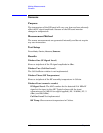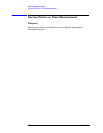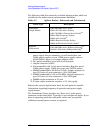
Chapter 4 153
Making Measurements
Using Baseband I/Q Inputs (Option B7C)
What are Baseband I/Q Signals?
In transmitters, the term baseband I/Q refers to signals that are the
fundamental products of individual I/Q modulators, before the I and Q
component signals are combined, and before up conversion to IF or RF
frequencies.
In receivers, baseband I/Q analysis may be used to test the I and Q
products of I/Q demodulators, after an RF signal has been down
converted and demodulated.
Why Make Measurements at Baseband?
Baseband I/Q measurements are a valuable means of making
qualitative analyses of the following operating characteristics:
• I/Q signal layer access for performing format-specific demodulation
measurements (e.g. CDMA, GSM, W-CDMA):
• Modulation Accuracy – i.e. I/Q plane metrics
— Rho
— Error Vector Magnitude; RMS, peak, 95%
— carrier feed-through
— frequency error
— magnitude and phase errors
• Code-domain analysis (including code-specific metrics)
• CCDF of I
2
+Q
2
• Single Sideband (SSB) metrics for assessing output quality
• Basic analysis of I and Q signals in isolation including: DC content,
RMS, P-P levels, CCDF of each channel
Comparisons of measurements made at baseband and RF frequencies
produced by the same device are especially revealing. Once signal
integrity is verified at baseband, impairments can be traced to specific
stages of up conversion, amplification, or filtering by RF analysis.
Likewise, impairments to signal quality that are apparent at RF
frequencies may be traceable to baseband using baseband analysis.


















